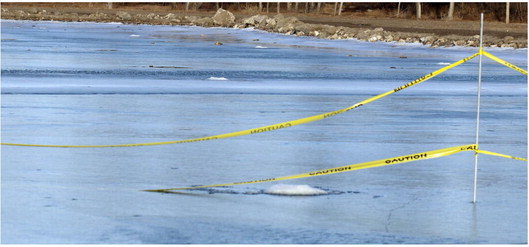Ice Safety Tips From FWP, Skaters Welcome In Culbertson


Despite mild weather recently, Ike’s Fishing Pond
and Walking Trail project manager Ken Forbregd told the Community News that ice skaters and hard water recreationists are welcome at the site. He said group of locals drilled approximately 15 holes in the ice Sunday, Nov. 6. With an average of 6-7 inches of ice, much of the pond is now open to skaters.
Visitors to the pond should be careful to avoid the southwest corner of the pond, said Forbregd, which is marked off with yellow caution tape. A solar-well-generated intake flow keeps the pond full and the ice near the hose unfrozen.
Forbregd said that Mike Wilson, Lary Pearson, Dale Wolff and Jens Nielsen were among the local group that checked the ice Sunday.
“It’s too bad there isn’t any fishing,” said Forbregd. “It’ll have to wait until next year.”
According to Marc Kloker from Fish, Wildlife and Parks, ice recreation season is beginning around the region and anglers and others are encouraged to practice safety. Said Kloker, “It’s that time of year when ice anglers and other recreationists will be heading out to Montana’s ‘hard waters’ for the winter season. Everyone needs to be safe around ice, whether ice fishing, ice skating, hunting, snowmobiling or just taking a walk. Montana Fish, Wildlife and Parks reminds folks that safety should be the number one concern during a day out on (or near) the ice.”
According to Kloker, anglers and other recreationists should be familiar with the water body they plan to fish or recreate on. The safest folks are those who pay as much attention to the changing conditions of the ice as they do to the fishing, skating or snowmobiling conditions.
And when on the ice, remember: •If you have even the slightest doubt about the safety of the ice — stay off it and keep pets away from it as well. Nothing is ever worth a fall into frigid water.
•Blue or “clear” ice is usually hard. Watch out for opaque, gray, dark or porous spots in the ice that could be weak, soft areas. Ice also tends to thin more quickly at the shorelines.
•Note areas on the ice that look “different” … they usually are. Many times, thinner areas of ice (caused by springs, gas pockets, sunken islands, points, etc.) have a different color or look to them. Use extreme caution or stay away from these areas.
•The following are recommended minimum ice thickness guidelines (for good, clear ice*): Remember, no ice is 100 percent safe!
Under 4 inches: Stay off!
4 inches: Ice fishing or other activities on foot
7 inches: Snowmobile or ATV
10 inches: Car or small pickup**
12 inches: Medium truck** **not recommended, but if you must, proceed at your own risk!
*for white ice or “snow ice,” double the above minimums
•Test the ice ahead of you with an ice spud bar or an auger.
•Watch for pressure ridges. These are areas of open water or thin ice where the ice has cracked and heaved due to expansion from freezing.
•Don’t leave children or pets unsupervised on the ice.
•Lakes and ponds do not freeze at the same thickness all over. Some ponds have windmills to aerate water for fish survival, and ice may be thin near these areas.
•Moving water — rivers, streams and springs — weaken ice by wearing it away from underneath. Avoid going on ice on rivers and streams, or where a river or stream enters a lake, pond or reservoir.
•The least safe ice usually occurs early and late in the season, when the weather is warmer and less predictable.
Some other common icesafety reminders to keep in mind include:
•Search for videos on ice safety and “what to do” if you should fall through the ice. One can be found here: https://www.youtube.com/ watch?v=5gOW8ZaYqHA.
•Consider changes in the weather (and ice conditions) during the prior 24 hours.
•It’s OK to wear a life jacket or carry a throwable floatation device while out on the ice — safe ice anglers and recreationists do it all the time.
•Dress warm but practical. Many styles of ice fishing jackets and bibs provide extra buoyancy to help keep you afloat if you do fall through.
•Before you leave the house, tell someone where you plan to go and when you plan to return.
•Carry a pair of ice picks (long spikes on a heavy string around your neck). If you break through the ice, you can use the spikes to grip the ice and pull yourself out of the water.



